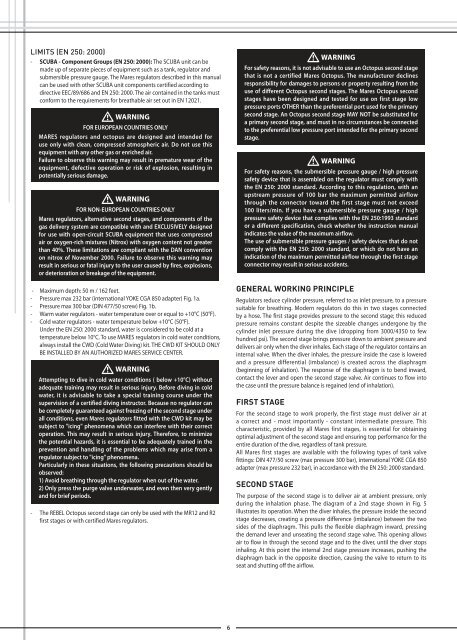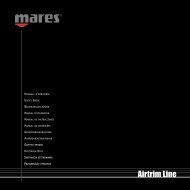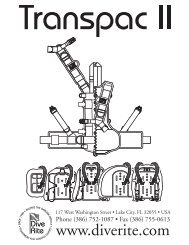Create successful ePaper yourself
Turn your PDF publications into a flip-book with our unique Google optimized e-Paper software.
LIMITS (EN 250: 2000)<br />
- SCUBA - Component Groups (EN 250: 2000): The SCUBA unit can be<br />
made up of separate pieces of equipment such as a tank, regulator and<br />
submersible pressure gauge. The <strong>Mares</strong> regulators described in this manual<br />
can be used with other SCUBA unit components certified according to<br />
directive EEC/89/686 and EN 250: 2000. The air contained in the tanks must<br />
conform to the requirements for breathable air set out in EN <strong>12</strong>021.<br />
� WARNING<br />
FOR EUROPEAN COUNTRIES ONLY<br />
MARES regulators and octopus are designed and intended for<br />
use only with clean, compressed atmospheric air. Do not use this<br />
equipment with any other gas or enriched air.<br />
Failure to observe this warning may result in premature wear of the<br />
equipment, defective operation or risk of explosion, resulting in<br />
potentially serious damage.<br />
� WARNING<br />
FOR NON-EUROPEAN COUNTRIES ONLY<br />
<strong>Mares</strong> regulators, alternative second stages, and components of the<br />
gas delivery system are compatible with and EXCLUSIVELY designed<br />
for use with open-circuit SCUBA equipment that uses compressed<br />
air or oxygen-rich mixtures (Nitrox) with oxygen content not greater<br />
than 40%. These limitations are compliant with the DAN convention<br />
on nitrox of November 2000. Failure to observe this warning may<br />
result in serious or fatal injury to the user caused by fires, explosions,<br />
or deterioration or breakage of the equipment.<br />
- Maximum depth: 50 m / 162 feet.<br />
- Pressure max 232 bar (international YOKE CGA 850 adapter) Fig. 1a.<br />
- Pressure max 300 bar (DIN 477/50 screw) Fig. 1b.<br />
- Warm water regulators - water temperature over or equal to +10°C (50°F).<br />
- Cold water regulators - water temperature below +10°C (50°F).<br />
Under the EN 250: 2000 standard, water is considered to be cold at a<br />
temperature below 10°C. To use MARES regulators in cold water conditions,<br />
always install the CWD (Cold Water Diving) kit. THE CWD KIT SHOULD ONLY<br />
BE INSTALLED BY AN AUTHORIZED MARES SERVICE CENTER.<br />
� WARNING<br />
Attempting to dive in cold water conditions ( below +10°C) without<br />
adequate training may result in serious injury. Before diving in cold<br />
water, it is advisable to take a special training course under the<br />
supervision of a certified diving instructor. Because no regulator can<br />
be completely guaranteed against freezing of the second stage under<br />
all conditions, even <strong>Mares</strong> regulators fitted with the CWD kit may be<br />
subject to "icing" phenomena which can interfere with their correct<br />
operation. This may result in serious injury. Therefore, to minimize<br />
the potential hazards, it is essential to be adequately trained in the<br />
prevention and handling of the problems which may arise from a<br />
regulator subject to "icing" phenomena.<br />
Particularly in these situations, the following precautions should be<br />
observed:<br />
1) Avoid breathing through the regulator when out of the water.<br />
2) Only press the purge valve underwater, and even then very gently<br />
and for brief periods.<br />
- The <strong>REBEL</strong> Octopus second stage can only be used with the MR<strong>12</strong> and R2<br />
first stages or with certified <strong>Mares</strong> regulators.<br />
6<br />
� WARNING<br />
For safety reasons, it is not advisable to use an Octopus second stage<br />
that is not a certified <strong>Mares</strong> Octopus. The manufacturer declines<br />
responsibility for damages to persons or property resulting from the<br />
use of different Octopus second stages. The <strong>Mares</strong> Octopus second<br />
stages have been designed and tested for use on first stage low<br />
pressure ports OTHER than the preferential port used for the primary<br />
second stage. An Octopus second stage MAY NOT be substituted for<br />
a primary second stage, and must in no circumstances be connected<br />
to the preferential low pressure port intended for the primary second<br />
stage.<br />
� WARNING<br />
For safety reasons, the submersible pressure gauge / high pressure<br />
safety device that is assembled on the regulator must comply with<br />
the EN 250: 2000 standard. According to this regulation, with an<br />
upstream pressure of 100 bar the maximum permitted airflow<br />
through the connector toward the first stage must not exceed<br />
100 liters/min. If you have a submersible pressure gauge / high<br />
pressure safety device that complies with the EN 250:1993 standard<br />
or a different specification, check whether the instruction manual<br />
indicates the value of the maximum airflow.<br />
The use of submersible pressure gauges / safety devices that do not<br />
comply with the EN 250: 2000 standard, or which do not have an<br />
indication of the maximum permitted airflow through the first stage<br />
connector may result in serious accidents.<br />
GENERAL WORKING PRINCIPLE<br />
Regulators reduce cylinder pressure, referred to as inlet pressure, to a pressure<br />
suitable for breathing. Modern regulators do this in two stages connected<br />
by a hose. The first stage provides pressure to the second stage; this reduced<br />
pressure remains constant despite the sizeable changes undergone by the<br />
cylinder inlet pressure during the dive (dropping from 3000/4350 to few<br />
hundred psi). The second stage brings pressure down to ambient pressure and<br />
delivers air only when the diver inhales. Each stage of the regulator contains an<br />
internal valve. When the diver inhales, the pressure inside the case is lowered<br />
and a pressure differential (imbalance) is created across the diaphragm<br />
(beginning of inhalation). The response of the diaphragm is to bend inward,<br />
contact the lever and open the second stage valve. Air continues to flow into<br />
the case until the pressure balance is regained (end of inhalation).<br />
FIRST STAGE<br />
For the second stage to work properly, the first stage must deliver air at<br />
a correct and - most importantly - constant intermediate pressure. This<br />
characteristic, provided by all <strong>Mares</strong> first stages, is essential for obtaining<br />
optimal adjustment of the second stage and ensuring top performance for the<br />
entire duration of the dive, regardless of tank pressure.<br />
All <strong>Mares</strong> first stages are available with the following types of tank valve<br />
fittings: DIN 477/50 screw (max pressure 300 bar), international YOKE CGA 850<br />
adapter (max pressure 232 bar), in accordance with the EN 250: 2000 standard.<br />
SECOND STAGE<br />
The purpose of the second stage is to deliver air at ambient pressure, only<br />
during the inhalation phase. The diagram of a 2nd stage shown in Fig. 5<br />
illustrates its operation. When the diver inhales, the pressure inside the second<br />
stage decreases, creating a pressure difference (imbalance) between the two<br />
sides of the diaphragm. This pulls the flexible diaphragm inward, pressing<br />
the demand lever and unseating the second stage valve. This opening allows<br />
air to flow in through the second stage and to the diver, until the diver stops<br />
inhaling. At this point the internal 2nd stage pressure increases, pushing the<br />
diaphragm back in the opposite direction, causing the valve to return to its<br />
seat and shutting off the airflow.





